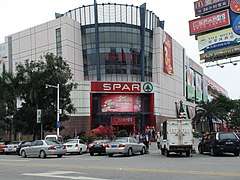South China Mall
 | |
| Location | Dongguan, China |
|---|---|
| Opening date | 2005 |
| Owner | Founder Group formerly Dongguan Sanyuan Yinghui Investment & Development |
| Total retail floor area | 659,611 square metres (7,099,990 sq ft) |
New South China Mall (Chinese: 新华南Mall; pinyin: Xīn huá nán; Jyutping: San1 waa4 nam4) in Dongguan, China is the largest shopping mall in the world when measured in terms of gross leasable area, and second in terms of total area to The Dubai Mall (which has extensive non-shopping space including a zoo, a hotel complex and a theme park).[1]
South China Mall opened in 2005 and for more than 10 years it was mostly vacant as few merchants ever signed up, leading it to be dubbed a dead mall.[2] In 2015 a CNN story reported that the mall had begun to attract tenants after extensive renovations and remodeling, though large portions still remained vacant.[3] By January 2018, after more than a decade high vacancy, most retail spaces are now filled and the mall features an IMAX-style cinema and theme park.[4]
History
The mall was built on former farmlands[5] in the Wanjiang District of Dongguan in southern coastal China. The project was spearheaded by Hu Guirong (Alex Hu[5]), who became a billionaire in the instant noodle industry. Upon opening, South China Mall became the largest mall in the world, surpassing the Golden Resources Mall. The cost of its construction is estimated around $1.3 billion.[2][6]
The mall was owned by Dongguan Sanyuan Yinghui Investment & Development (东莞市三元盈晖投资发展有限公司),[7] Hu Guirong's company, but a controlling interest in the mall was later sold to Founder Group, a division of Peking University.[2]
After opening in 2005, the mall suffered from a severe lack of occupants. Targeted initially to an affluent market (the big cities of Guangzhou and Shenzhen are adjacent), Dongguan is itself mainly a city of low income migrant laborers who failed to respond to all the attractions the mall had to offer.[3] Much of the retail space remained empty, with over 99% of the stores still vacant in 2008.[2][8] The only occupied areas were near the entrance where several Western fast food chains are located and a parking structure re-purposed as a kart racing track.[9] A planned Shangri-La Hotel was not completed.
Filmmaker Sam Green made a short film about the South China Mall called Utopia Part 3: the World's Largest Shopping Mall which premiered at the 2009 Sundance Film Festival and was broadcast on PBS's documentary series POV.
Originally called "South China Mall", the centre was redubbed as "New South China Mall, Living City" in September 2007.[10][11] The 2007 makeover was orchestrated by Founder Group, which took over the property from the original owner Hu Guirong in December 2006.[12]
In 2013, Vagabond Journey writer Wade Shepard wrote about his recent visit to the mall. He acknowledged that most visitors attend the mall for its movie theaters featuring IMAX, and that families did gather in the play area. He also noticed that 4 full floors of the mall were unused, and that the water of the artifical indoor canals had turned green.[13][14]
Description

With over a total area of 892,000 square metres (9,600,000 sq ft),[7] and almost 660,000 square metres (7,100,000 sq ft) of leasable space[1] sufficient for as many as 2,350 stores.[15]
The mall has seven zones modeled on international cities, nations and regions, including Amsterdam, Paris, Rome, Venice, Egypt, the Caribbean, and California. Features include a 25-metre (82 ft) replica of the Arc de Triomphe,[7] a replica of Venice's St Mark's bell tower,[2] a 2.1-kilometre (1.3 mi) canal with gondolas,[7] and a 553-metre (1,814 ft) indoor-outdoor roller coaster.[16]
See also
References
- 1 2 Van Riper, Tom (2008-01-18). "The World's Largest Malls". Forbes. Retrieved 2009-09-20.
- 1 2 3 4 5 Donohue, Michael (2008-06-12). "Mall of misfortune". The National. Abu Dhabi Media Company. Archived from the original on 2011-05-01. Retrieved 2010-01-12.
Location: Dongguan, China Year Opened: 2005 Gross Leasable Area: 7.1 million square feet
- 1 2 Nylander, Johann (28 April 2015). "Chinese 'ghost mall' back from the dead?". CNN. Retrieved 29 April 2015.
- ↑ https://theculturetrip.com/asia/china/articles/worlds-biggest-shopping-mall-china-no-longer-ghost-mall/
- 1 2 Utopia, Part 3: The World’s Largest Shopping Mall, August 18, 2009, Retrieved February 9, 2010
- ↑ David Barboza (May 25, 2005). "China, New Land of Shoppers, Builds Malls on Gigantic Scale". The New York Times. Retrieved 15 August 2018.
- 1 2 3 4 Matthew Benjamin and Nipa Piboontanasawat (April 17, 2007). "China's mall glut reflects an unbalanced economy". The New York Times. Retrieved February 8, 2010.
- ↑ Donohue, Michael (2008-06-12). "Mall of misfortune". The National. Abu Dhabi Media Company. Retrieved 2008-07-17.
- ↑ Jo Steele (October 29, 2009). "Welcome to the loneliest shopping mall in the world". Metro. Retrieved February 8, 2010.
- ↑ "华南MALL"变脸"突围 昨起变更为新华南MALL·生活城". Nanfang Daily (in Chinese). September 20, 2009. Retrieved February 15, 2010.
- ↑ "Upcoming Events at the New South China Mall". Retrieved 2009-01-15.
- ↑ "Wan China Times, Taiwan".
- ↑ Adam, Taylor (5 March 2013). "Tour China's Enormous 'Ghost Mall' That Sits Virtually Empty Years After It Was Built". Business Insider. Retrieved 6 August 2018.
- ↑ Shepard, Wade (6 January 2013). "New South China Mall: An Update On The World's Largest (Ghost) Mall". Vagabond Journey. Retrieved 6 August 2018.
- ↑ "区域规划". Archived from the original on 2009-12-08. Retrieved 2010-02-16.
- ↑ "The Not-So-Great Mall of China: Welcome to the world's largest (and loneliest) shopping centre". Daily Mail. October 29, 2009. Retrieved February 9, 2010.
External links
| Wikimedia Commons has media related to New South China Mall. |
- Official website
- Utopia, Part 3, PBS documentary on South China Mall, August 18, 2009. Note: this documentary is actively filtered to prevent non-US visitors from accessing the content.
Coordinates: 23°2′15″N 113°43′14″E / 23.03750°N 113.72056°E